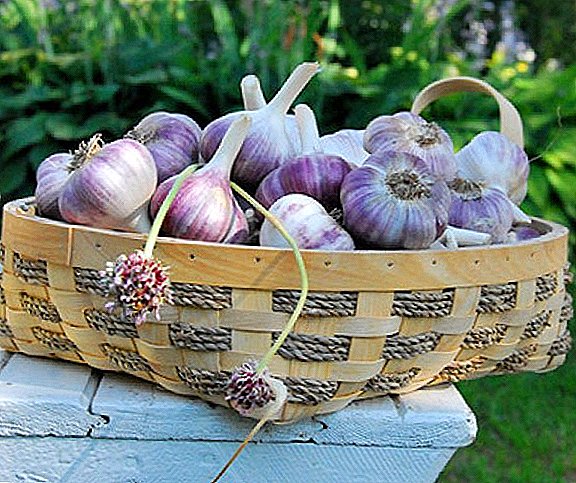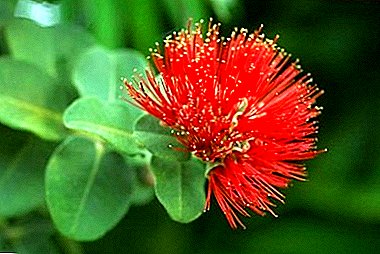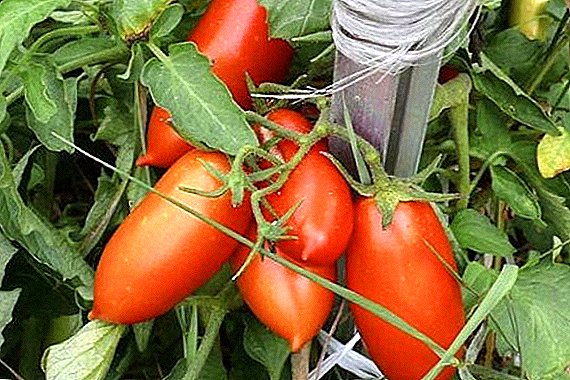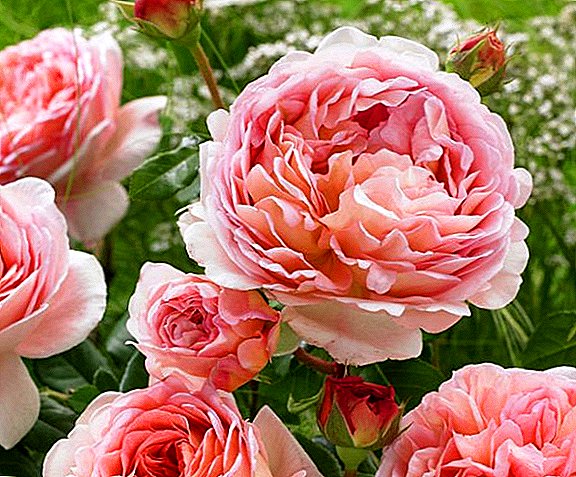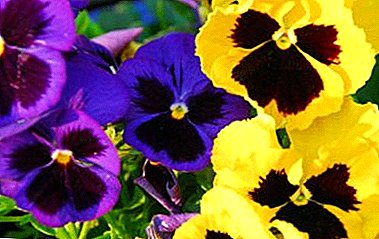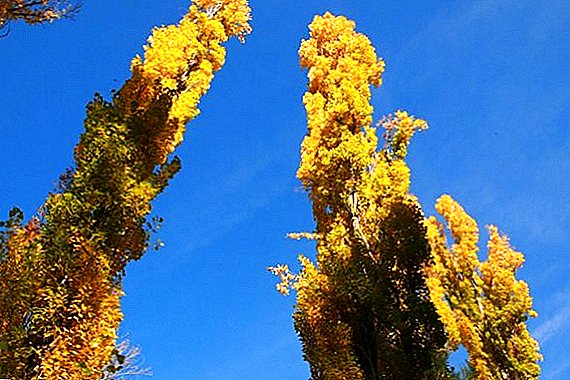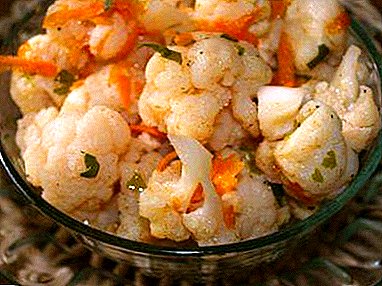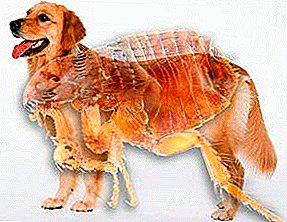 Onions are grown on almost every site, because it is incredibly useful, due to the high content of vitamins and minerals, as well as indispensable in the preparation of various dishes. Therefore, it is really difficult to imagine a garden where there are not even a few beds of this plant. Today we will tell you about this sort of onion, as "Stuttgarter Riesen", consider its advantages and disadvantages, as well as features of planting and care.
Onions are grown on almost every site, because it is incredibly useful, due to the high content of vitamins and minerals, as well as indispensable in the preparation of various dishes. Therefore, it is really difficult to imagine a garden where there are not even a few beds of this plant. Today we will tell you about this sort of onion, as "Stuttgarter Riesen", consider its advantages and disadvantages, as well as features of planting and care.
Variety description
Variety "Stuttgart Riesen" comes from Germany and belongs to the mid. Bulbs are characterized by large sizes (150-180 g), as well as flattened shape. The peel is colored pale yellow or brown-yellow with a milky shade of color. Inside the fruit is white and juicy, there is a pleasant sharpness in taste.
Check out the characteristics of the following varieties of onions: "Exibichen", "Sturon", "Red Baron", "Centurion", "Carmen", "Setton".
The advantages of this onion include:
- high yield;
- unpretentiousness in landing and leaving;
- early maturation;
- universality in use: fruits can be dried, frozen, canned, used for dining purposes and added to various dishes;
- good preservation;
- beautiful presentation and the ability to transport over long distances;
- resistance to diseases and pests;
- the possibility of growing greens.

Did you know? After the bites of bees, bumblebees and wasps, it is enough to anoint the affected area with onion juice. It will remove the pain and swelling.Among the disadvantages of this variety of onions are the fact that it does not tolerate excessive moisture and in the conditions of rainy summer is often affected by rot, and some note that because of the flattened shape, the fruit is not very convenient to clean and cut. Otherwise, the reviews of "Stuttgarter Riesen" only positive.
Distinctive features of these bulbs are:
- unusual flattened shape;
- high content of vitamin C and dry matter;
- no need for chemical treatment of pests and diseases;
- not afraid of the cold;
- can grow on any soil.
It is interesting to get acquainted with various types of onions - allium, shallot, leek, stacked, chives, batun, slizunom.
Characteristics of onions and yield
When planting a planting plant, the Stuttgarter Riesen ripens in 2-2.5 months, and when sowing seeds, in 3-3.5 months, that is, the crop is harvested around the end of July and the beginning of August. The variety has a high, stable productivity: with proper care from 1 square. m planting collect 5-7 kg of crop.

Selection of planting material
Onions "Stuttgarter Riesen" can be planted with the help of sevka and seeds. Sevok should be approximately the same size, not have mechanical damage and traces of rot. It should also be noted that small onions are better to plant in the fall, and larger ones in the spring.
The seeds of this onion are called chernushka, they are rather small and painted black. It is recommended to buy planting material from trusted vendors at specialized points of sale. Be sure to pay attention to the shelf life of seeds, which must be indicated on the package.
Important! The seeds of the onion "Stuttgarter Riesen" are very susceptible to temperature extremes, have low germination rates, and the plants planted when using this material grow much more slowly than when planted with planting.
Growing conditions
For this varieties of onions are suitable only sunny beds, on which there is enough light. The landing area should also be well ventilated. The plant normally tolerates low temperature, as well as its fluctuations, but in priority, of course, moderate and high temperatures. "Stuttgart Riesen" does not tolerate stagnation of moisture, so it is necessary to ensure good drainage on the beds if there is a risk of a similar problem.

Soil and fertilizer
The best option for planting is fertile loamy chernozem. Although any other soil may be suitable for this variety of onions, the only main condition for successful cultivation is a neutral pH, since Stuttgarter Riesen does not grow on acid soils.
Organic matter should be used as supplements, it can be compost, manure, chicken manure or humus, as well as mineral complexes.
Important! The best precursors for this onion are tomatoes, cabbage, pumpkin, zucchini, cucumbers, basil and legumes, but after potatoes, celery and garlic it is not recommended to plant it.
Growing from seed to seedlings at home
In order to get a good harvest, you need to know some secrets about how to properly prepare and plant seeds. Let's consider all the details of a successful landing in this way.

Seed preparation
Regardless of how much you trust the seller, the planting material will certainly need to be disinfected. This can be done simply by soaking the seeds in a weak solution of potassium permanganate. After that, the seed must be thoroughly dried, for example, on the battery.
Learn more about how to grow onions from seed.
Content and location
After disinfection and drying, niece can be sown directly on the garden bed or grown on seedlings. The optimal time for sowing seedlings - the beginning of March. First of all, it is necessary to “awaken” the planting material by placing it for 24 hours in warm water. Planting containers should be filled with fertile, loose soil and placed in a warm, well-lit place.
Did you know? In order to prevent cancer, you should regularly eat onions. Its taste and even the tears that occur when cleaning and slicing it, help the human body fight cancer cells.
Seed planting process
In the next stage, you need to make grooves 2 cm deep, place the seeds in them at a distance of 0.5 cm from each other and slightly compact the soil. Then it is necessary to water them abundantly and move the pots with seedlings to a warm place.

Seedling care
After the first shoots appear, the seedlings are moved to a cool place where the temperature does not exceed +16 ° C. If the seedlings are too thick, they must be thinned. Seedlings should provide regular abundant watering.
Transplanting seedlings to ground
By the end of May, that is, 2 months after sowing of the black hole, 2-3 seedlings will appear on the seedlings, and it will be ready for transplanting into open ground. Before moving it to the garden bed, cut all the green feathers by 3/4.
After that, the seedlings are planted at a distance of 25 cm from each other so that the bulbs have enough space to grow.
After transplanting the plant, it is necessary to water it regularly, weed the beds of weeds, and also loosen the soil.
Did you know? In the onion there is more sugar than in apples and pears - more than 6%. After heat treatment, this sweetness becomes very pronounced.

Cultivation from sevka in open ground
In the spring or in the autumn landing of sevka is carried out. Such a method is considered more efficient and less troublesome than the sowing of blacksmiths. Let's look at step by step how to plant the onion "Stuttgarter Riesen" in this way.
Learn how to plant onions for the winter and spring, what to do with the arrow, how to fertilize onions, how and when to water.
Site selection and soil preparation
Onions "Stuttgart Riesen" can be grown on the beds, and in the greenhouse. In greenhouses, it is often grown to produce greens. A landing site must be sunny and well ventilated. The plant prefers a light, nutritious soil, so the beds must first be prepared. It is recommended to loosen the soil and fertilize it with compost, humus or peat.
Seed preparation
Planting material must be sorted and calibrated, and then warmed up. Sevok placed on the battery for 7-8 hours, and then soaked in warm water (+ 37-40 ° C) with potassium permanganate for 12 hours. This will help and sanitize and awaken the onions. Then sevok spread on burlap and dried.
It is also worth noting that if a sevok is planted for forcing, it is better to trim the tops of the onions in order to speed up the process of the emergence of the feathers.

The process of planting sevka in the ground
At the site for planting, it is necessary to make grooves with a depth of 2-3 cm, the interval between rows should be at least 20 cm. Onions are planted in the ground at a distance of 15-20 cm from each other. After all sevka is placed in grooves, it is sprinkled with soil and peat. Pay attention to the fact that it is not necessary to tamp the ground.
Did you know? Onion helps to burn fat, there is even a popular diet based on eating the soup from this vegetable for 2 weeks, and the results, judging by the reviews, are very impressive.
Watering
In hot, dry weather, onions are watered every other day until the beginning of July. For water treatments it is better to use water heated in the sun. If the summer is rainy, then you need to water the onions only after the ground dries.
In July, watering is stopped in order to keep the future harvest well, as excessive moisture can cause decay and poor bulging of the bulbs. In the event that summer is very hot, the beds can be irrigated with water until mid-July.

Soil loosening and weeding
After watering and rain, the soil around the plants must be loosened in order to ensure the access of oxygen to the bulbs and to avoid stagnation of moisture. And, naturally, the beds should be weeded regularly.
Top dressing
The bow "Stuttgarter Riesen" is very responsive to top dressing, therefore they are recommended to be carried out three times during the growing season. The first time fertilizers are applied 14 days after planting. It is best to use for this purpose organic matter diluted in water.
1 liter of manure or poultry manure is diluted in 5 liters of water and the mixture is infused for 2 weeks. Then it is necessary to dilute the fertilizer with water at the rate of 1 liter of top dressing from chicken manure to 20 liters of water and 1 liter of manure tincture to 6 liters of water.
After 30 days, the onions are fertilized again. For the second dressing, potassium salt (40 g), urea (15 g) and superphosphate (15 g) are diluted in one bucket of water and water is poured over the beds.
The third time fertilizer is applied during the formation of the bulbs. Experienced gardeners recommend using superphosphate (30 g) and potassium salt (15 g) diluted in 10 liters of water as a top dressing.
About fertilizer, chemical weeding and watering: video
Pests, diseases and prevention
The variety of onions "Stuttgarter Riesen" is highly resistant to diseases and pests. Subject to the use of quality planting material and compliance with the rules of agricultural technology, the plant is very rarely sick. The cause of the disease can be the stagnation of moisture, which leads to rotting, so you should regularly loosen the ground and be wary of watering.
Learn more about the diseases and pests of onions, especially about the onion fly.
As a preventive measure for diseases, it is necessary to disinfect sevok and seeds before planting. And to prevent the emergence of parasites will help correctly chosen neighbors in the garden: for onions, "Stuttgarter Riesen," the best defenders against parasites are dill and carrots.
About preventive treatments: video
It is important to know when to dig onions, how to store, how to braid an onion braid for decoration and storage.
Harvesting and storage
The signal that the crop is ready is the yellowing and drying leaves on the onion. Tightening with the harvesting of onions is not worth it, since it can begin to germinate again, which will negatively affect the keeping quality of fruits and their taste.
After collecting the bulbs, cut off the dried leaves and roots and dry the fruits. You can dry them, laid out in the sun, or, if this is not possible, in a suspended state in a dry and well-ventilated room.
Important! Small immature fruits - sets - should also be dried, and then folded in boxes filled with sand, and stored in a cool place until next season.The bow "Stuttgarter Riesen" is notable for its good quality. It is perfectly preserved until spring, if you store it in a dry, dark, cool room.

Possible problems and recommendations
Sometimes gardeners face difficulties in growing Stuttgarter Riesen, most often problems associated with a deficiency of nutrients, namely:
- Lack of nitrogen leads to slower growth, yellowing and death of foliage. Deficiency of phosphorus causes blackening on the tips of old leaves. A lack of potassium can lead to the fact that the leaves turn pale, curl and wrinkle, and even ensuring regular watering does not improve their condition. Plants that lack potassium are more susceptible to fungal diseases. To remedy the situation with the lack of nutrients can be done by making the missing elements in the ground.
- An overabundance of micro and macro elements also negatively affects the plant, it can provoke slower growth and other problems associated with the development of bulbs.
- Lack of sunlight and light can adversely affect the taste of the crop, the bulbs acquire bitterness, which does not paint them at all, so the choice of a place to plant should be treated responsibly.
And to make it tasty all year round, learn how to grow green onions on the windowsill, how to prepare onions for the winter, green onions for the winter.Now you know that everyone can grow onions in the “Stuttgarter Riesen” variety on their site. Its fruits are very useful due to the high content of ascorbic acid, as well as it is well kept and versatile to use. Planting and caring for a plant does not take much time and effort, and the harvest will certainly please with large and numerous fruits.
How to grow onions "Stuttgarter Riesen": reviews
1. not all onion seeds, even those advertised by the "producer", correspond to what is written on the bag. I have not a single "commodity" bulb not grown. Although even on a bag of seeds "stuttgart" it was written that you can grow a commodity bulb in one year
2. Not every sevok sold in "garden" stores corresponds to the name of the variety. In the spring I saw several outlets selling sevka under the Stuttgart brand, although obviously the Stuttgart sevka was a clear minority in the "assorted sevka" that was sold. two or three to "mass" demand. and even better to grow your sevok.

Tanya - you will reap what you sow, so a small set, sluggish - into culling, especially in 50p., We have it 180p. and then reject.
Bulk plant, whatever you plant will be a trifle, transplant, extra work.
So in the spring I plant a bow, by the way, also Stuttgart, a distance of 10-15cm between the bulbs. spacing not less than 15cm. Be sure to sprout up, sideways - there will be a problem. Planting depth is 1 cm above the bulb. soil. while growing, I sprinkle with wood ash, this is both fertilizer and prevention from onion flies, I don’t use chemicals - there’s no point in it. And even during the growth of the stems on the greens DO NOT RIP, since you deplete the onion itself. Once every 10 days, water the infusion of mullein.
You should be able to. This is our problem - it’s time to clean, but it doesn’t dry, it often rains, it doesn’t give off the stems.
We clean with green stems, pruned, dry and until spring enough. I do not know about you, but we do not plant onions for winter in Kamchatka.



